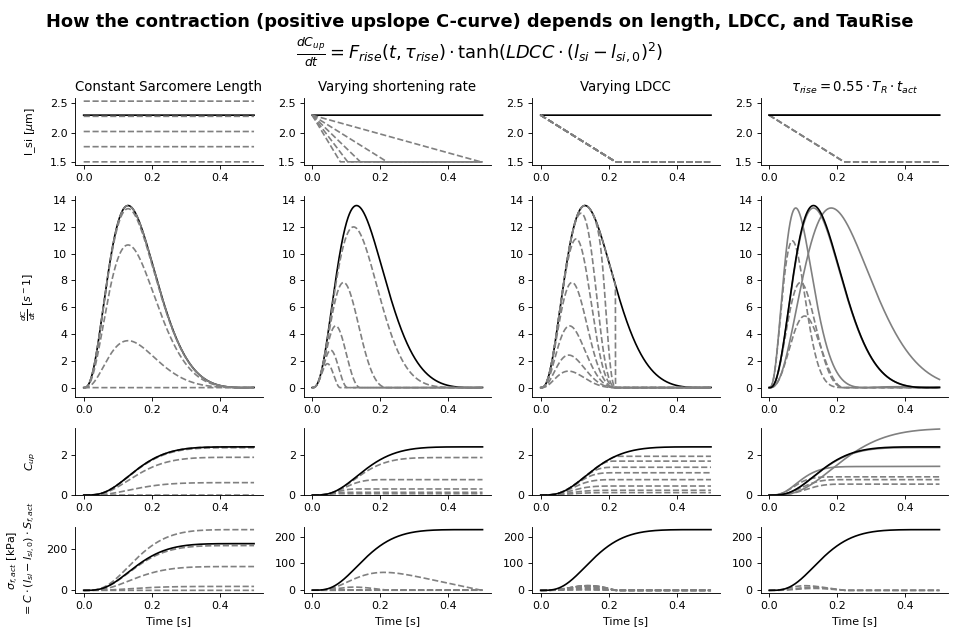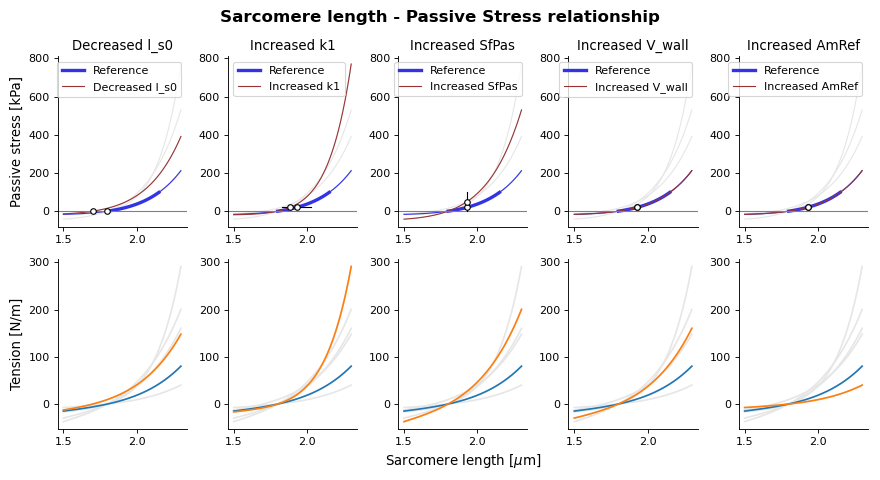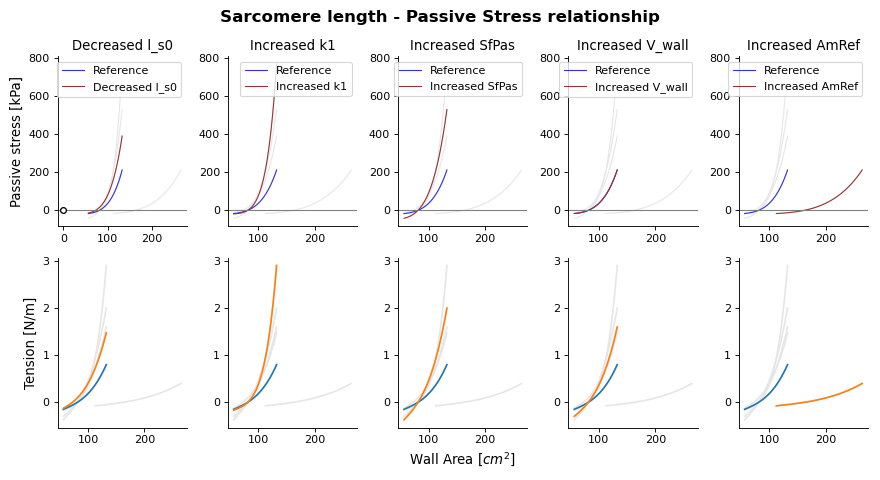Patch2022
Patch2022 is based on Patch in Walmsley 2015. |
Patch is introduced [Walmsley2015]
Documentation
Patch2022 is based on Patch in Walmsley 2015.
Parameters
- Am_ref: float
Reference wall area at \(l_{s} = l_{s,ref}\).
- V_wall: float
Wall volume
- v_max: float
Maximum shortening velocity
- l_se: float
lgth of the series elastic element, i.e. \(l_{s} -l_{si}\) for which stress is zero.
- l_s0: float
Reference sarcomere lgth for which at \(A_m (l_{s,ref}) = A_{m,ref}\).
- l_s0: float
Zero passive stress lgth
- dl_s_pas: float
- Sf_pas: float
Linear ECM stress coefficient
- k1: float
Nonlinear exponent ECM stress component
- tr: float
Contraction time constant
- td: float
Relaxation time constant
- time_act: float
Relative contraction duration
- Sf_act: float
Linear active stress component
- dt: float
Activation delay relative to intrinsic activation
- C_rest: float
Rest contractility
- l_si0: float
Reference lgth for zero-active-stress
- LDAD: float
lgth dependend activation duration
- ADO: float
activation duration offset
- LDCC: float
lgth dependend contractility coefficient
- Sf_pasMaxT: float
Maximum ecm stress (adaptation sens variable)
- Sf_pasActT: float
Active weighted passive stress (adaptation sens variable)
- FacSf_actT: float
Active stress (adaptation sens variable)
- LsPasActT: float
Weighted sarcomere lgth average (adaptation sens variable)
- adapt_gamma: bool
Adaptation constant
Signals
Signals are arrays. Each point in the array represents a point in time with step-size controlled by the solver.
- l_s: array
Sarcomere lgth
- l_si: array
State variable: Intrinsic sarcomere lgth
- LsiDot: array
State variable: Intrinsic sarcomere lgth time-derivative
- C: array
State variable: contraction curve
- C_dot: array
State variable: contraction time-derivative
- Am: array
Patch mid-wall area
- Am0: array
Patch mid-wall zero-stress area
- Ef: array
Natural strain
- T: array
Mid-wall tension
- dA_dT: array
Area-tension derivative
- Sf: array
Total fibre stress at mid-wall
- Sf_pasT: array
Total passive stress at mid-wall
- SfEcm: array
Total ECM stress at mid-wall
- dSf_dEf: array
Total stiffness coefficient
- dSf_pas_dEf: array
Total passive stiffness coefficient
- SfEcmMax: array
Adaptation: Maximum ECM stress
- Sf_actMax: array
Adaptation: maximum active stress
- Sf_pasAct: array
Adaptation: active-weighted passive stress
- LsPasAct: array
Adaptation: active-weigthed sarcomere lgth
The myocardial tissue module Patch takes as its inputs mid-wall segment area A_m and time t, and outputs fibre stiffness (dA_m)/dt and zero-tension reference area A_m0. Each initialized module object consists of two state variables, namely the contractile element length l_si and the contractility curve C. Myocardial tissue is deformable (soft) and incompressible. Sarcomere mechanics are assumed homogeneous in a single segment, meaning one single sarcomere represents the entire segment. A sarcomere is modelled as a three-element Hill contraction model [FUNG ], in which the elastic element (with length l_se) and contractile element (with length l_si) in series are in parallel with an elastic element (l_s=l_se+l_si), which is calculated as
in which \(l_{s,ref}=2\) is the reference length of the sarcomere at reference wall area A_(m,ref). The intrinsic sarcomere length is a delayed image of the sarcomere length and is given by the following differential equation
Active behavior
in which v_max is the unloaded sarcomere shortening rate and l_(se,iso) the length of series elastic element. The total sarcomere length will decrease at a rate proportional to the length of the series elastic element when the cell is unloaded [deTOMBE]. Total fibre stress is the sum of two stress components, an active stress generated by sarcomere contraction, and a passive stress arising from structures such as the ECM and titin. Both passive and active stress depend upon the length of the sarcomere.
Active stress generation The active stress depends also on time through a ‘contractility’ parameter. Contractility is a phenomenological quantity representing the density of cross-bridges formed in the sarcomere. There is a resting value of contractility, which may be non-zero. This can represent residual cross-bridge formation during diastole. Contractility increases when the tissue is activated. Activation is smooth and has a rise and decay phase with different time constants. The rate of change of contractility increases with sarcomere length [KENTISH]. Active stress increases with contractility, contractile element length and series elastic element length. Based on these assumptions, the contractility curve C is implemented as a state-variable and given by
with
activation function F_rise (t)
Crossbridge formation function C_L (l_{si} )
Decay function g(X)
From the contractility curve, the total active stress is calculated using
(Source code, png, hires.png, pdf)

Passive behavior
(Source code, png, hires.png, pdf)

Passive stress-strain relation as function of sarcomere length
(Source code, png, hires.png, pdf)

Passive stress-strain relation as function of wall area
Assumptions
Not Included in this Version of the Model:
Force-frequency relationship (force of contraction increases with heart rate).
Electrophysiology model, only imposed activation times.
Biophysics / energetics of calcium transient, cross-bridge formation, etc - currently, this is modelled phenomenologically and availability of ATP is assumed to be infinite.
Sympathetic / para-sympathetic stimulation of cardiomyocytes.
References
A citation (as often used in journals).